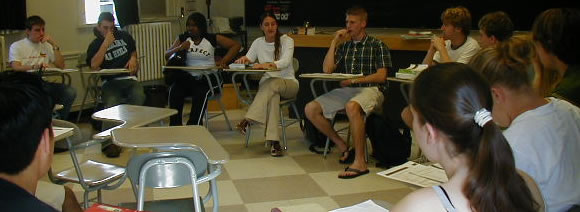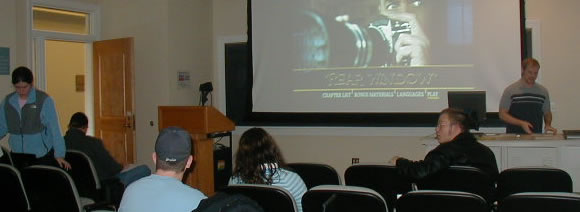Negotiating Space in a Laptop Classroom

How do you read the social space of this circle?
Mouse over the image. How does the single laptop change your
perception
of
this classroom? What if all students had their laptops out?
Perhaps no other materiality of classroom life has received more attention than furniture arrangement. [For a recent discussion and bibliography of furniture for technology classrooms, see Kimme Hea and Menchaca.] The iconic representation of a de-centered classroom is the circle of desks, indicating that the instructor has moved from being a lecturer to a discussion facilitator. Though no one believes that a particular arrangement magically produces a particular kind of social space, furniture should not be ignored as a marker of power dynamics or as an ergonomic concern.

Compare your read of the previous two images with
this image.What are your assumptions about the social space based on the
material space? [This classroom has stadium seating.]
In a wireless classroom, the projection screen means that the circle of desks become a horseshoe; the pedagogical lens that sees circles as signs of student-centeredness sees that horseshoe configuration as a sign of what Hillocks called the presentational style—a hallmark of a traditional, authoritarian instructor. Though I would not argue that instructors in wireless classrooms are less likely than any other instructors to become presenters, I think that the complexity of a wireless classroom requires new ways of coding the interactions between
- the instructor and students,
- students and other students,
- the instructor and the instructor’s laptop connected to a projector,
- students and the instructor’s laptop as projected,
- students and their laptops,
- the instructor’s laptop and students’ laptops via a network,
- students and other students’ laptops via a network, and
- students and other students’ laptops by proximity.
Until these codes lead us to a new lens for noticing power dynamics in wireless classrooms, the questions that need answering are:
- What kinds of physical interactions between the instructor, students, and laptops are necessary for accomplishing the curriculum?
- Why are such interactions considered necessary?
- How can those physical interactions happen given the current classroom furniture?
My Own Perspective |
||
Physical Interaction |
Justification |
Material Space Need |
I want to be able to project from my laptop so that I can demonstrate
computer-mediation, model draft workshops, archive class discussions,
connect to web resources, and post multi-tasking daily assignments
for self-paced work. |
Whatever is projected from my laptop becomes
a center of gravity for the class period. Laptop projection allows
me to act as a presenter,
a discussion facilitator, a secretary, a quasi-reference
librarian, and a task-assigner. |
All students need to be able to see the projection screen. |
I want to be able to interact with each student and his/her laptop
individually. |
Individual attention builds relationships and
increases my ability to respond to particular needs. |
I need walk room between students and standing room near each student. |
Students need to be able to talk to each other in groups of 3-5
while they accomplish computer-mediated composing tasks. |
Collaboration complicates composing tasks in
ways that improve students’ abilities to approach rhetorical
situations and negotiate courses of action. It also allows more
students to be experts in a broader
spectrum of specializations. |
Students need to be able to move between facing the projection
screen and facing each other with as little chaos as possible. Their
own laptop screens must not obstruct their view. |
Despite my understanding of how I want the material space to enable
classroom life, I often find myself and my
students trapped by furniture.